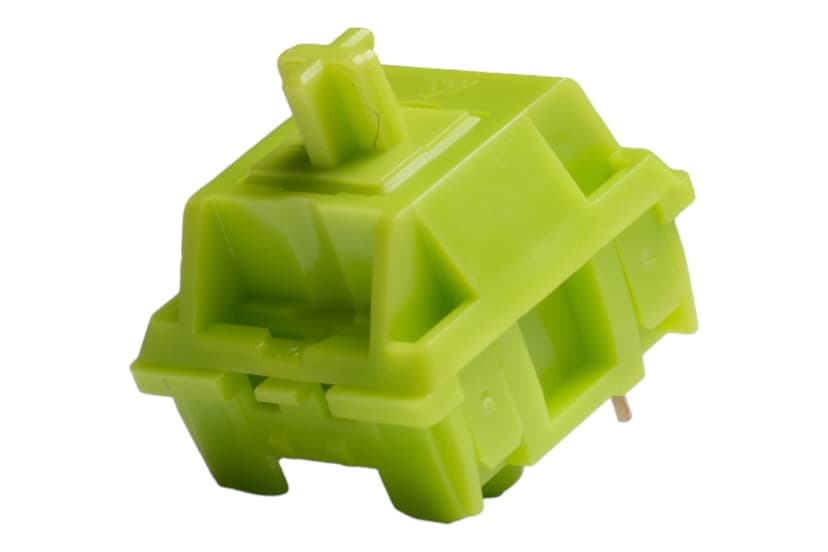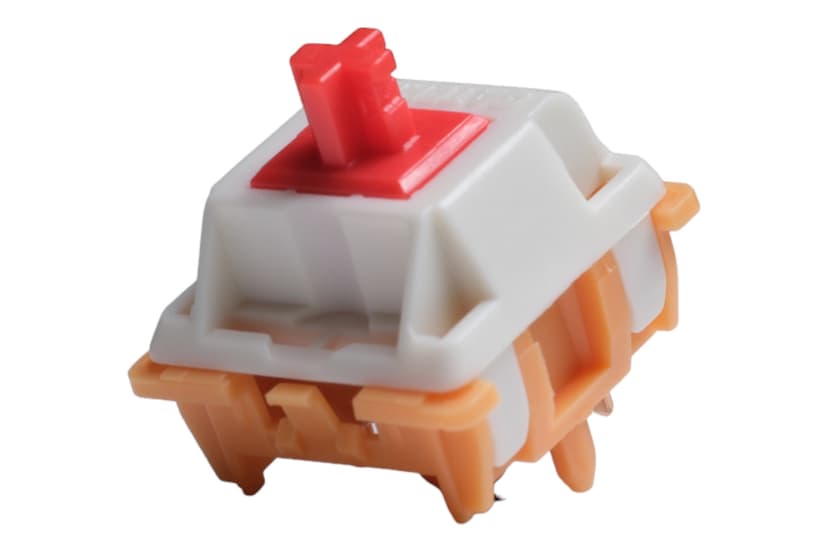KTT Matcha vs. Gateron Mini i
An in-depth look at the KTT Matcha and the Gateron Mini i switches—which one is the best fit for you?
Overview
The KTT Matcha and the Gateron Mini i are both tactile switches that offer unique typing experiences. The Matcha is known for its comfortable and snappy tactility, providing a clean bottom-out sound with its long pole stem. On the other hand, the Mini i switches offer a gentle tactility and a fairly muted sound profile, making them ideal for office environments. While the Matcha is categorized as 'Stepped', 'Snappy', 'Accented', 'Clacky', 'Feathery', and 'Subtle', the Mini i is labeled as 'Bouncy', 'Easy-to-press', 'Mild', 'Neutral', 'Snappy', 'Subtle', and 'Stepped'. However, let's dive in a bit deeper beyond generalities so you can best decide on the best switch for you.
By the numbers
Technical specifications
Actuation force
40g
Actuation force
40g
Bottom-out force
45g
Bottom-out force
50g
Pre-travel
1.90 mm
Pre-travel
1.40 mm
Total travel
4.00 mm
Total travel
3.40 mm
Factory lubed
Yes
Factory lubed
Yes
Stem construction
Standard
Stem construction
Standard
Stem material
POM
Stem material
POM
Top housing material
Polycarbonate
Top housing material
Nylon
Bottom housing material
Polycarbonate
Bottom housing material
Nylon
Mount type
Plate (3-pin)
Mount type
PCB (5-pin)
Spring
Gold-plated spring
Spring
22mm double-stage spring
Housing materials
In comparing the housing materials of the KTT Matcha and the Gateron Mini i, one key difference lies in their top housings. The Matcha utilizes polycarbonate for its top housing, resulting in a sharper, higher-pitched, and crisper sound profile. This is due to polycarbonate being a stiffer plastic, which contributes to a clear and resonant sound. On the other hand, the Mini i opts for a nylon top housing, which produces a deeper and fuller sound profile. Nylon, being a softer plastic, absorbs more sound, creating a duller and rounder tone. Therefore, the choice between polycarbonate and nylon for the top housing can greatly impact the overall sound experience of these switches.
Moving on to the bottom housings, both the Matcha and the Mini i share a commonality in using polycarbonate for this component. As with the top housing, the polycarbonate bottom housing contributes to a sharper, crisper sound profile. It also offers the benefit of translucency, making it ideal for switches designed to showcase RGB lighting. In contrast, the Mini i's choice of nylon for its top housing again results in a deeper and fuller sound. The softer nature of nylon allows for more sound absorption, resulting in a rounder tone compared to the crisper sound produced by polycarbonate. Ultimately, the housing material chosen for the bottom section of a switch can have a significant impact on the overall typing experience.
Overall, the housing materials of the KTT Matcha and the Gateron Mini i play a crucial role in shaping the sound profile and feel of these switches. While both switches utilize polycarbonate for their bottom housings, their choice of material for the top housing sets them apart. The Matcha's polycarbonate top housing produces a sharper and crisper sound, ideal for those seeking a more precise typing experience. In contrast, the Mini i's nylon top housing offers a deeper and fuller sound, catering to those who prefer a softer and more rounded tone. Whether you prioritize clarity and resonance or depth and fullness in your typing sound, the housing materials of these switches offer distinct characteristics to suit different preferences.
Weight
The KTT Matcha tactile switch and the Gateron Mini i tactile switch both have a light actuation force of 40 grams, making them equally responsive when triggering a keystroke. However, when it comes to the bottom out force, the KTT Matcha requires 45 grams to fully press down, while the Gateron Mini i needs 50 grams. This means that the Gateron Mini i provides a slightly heavier and more substantial typing experience compared to the KTT Matcha. Weight is an important factor to consider when choosing between the two switches, as some users may prefer the lighter actuation force of the KTT Matcha for longer typing sessions or gaming, while others may prefer the heavier bottom out force of the Gateron Mini i for a more solid and tactile feel while typing. Ultimately, the choice between the two switches will depend on personal preference for actuation and bottom out forces.
Travel distance
The KTT Matcha tactile switch has a travel distance of 4 mm, while the Gateron Mini i tactile switch has a travel distance of 3.4 mm. The Matcha offers a slightly longer travel distance compared to the Mini i, making it more suitable for those who prefer a deeper press when typing. On the other hand, the Mini i provides a shorter travel distance, making it ideal for gamers or individuals looking for faster response times. Both switches offer different experiences when it comes to travel distance, catering to different preferences. Ultimately, the choice between the two will depend on whether you prefer a longer or shorter travel distance for your typing or gaming needs.
Price comparison
Which switch is more bang for your buck?
The KTT Matcha has an MSRP of $5.20 per 10 switches. At Milktooth, we are able to pass on savings to our customers and offer the Matcha for $4.88.
The Gateron Mini i comes in at $6.00 per 10 switches.
Here at Milktooth, we offer the best prices on switches (on average, 27% lower the competition). In addition, we offer free shipping on orders over $49.00. We also offer free returns and exchanges, so you can shop with guaranteed satisfaction.
That said, while price is an important piece of the puzzle, our opinion is that you should ultimately pick the option that most suits your unique preferences since you’ll be using these switches for years to come. In other words, finding something perfect for you is, in our view, the most important criteria.
Typing experience
When it comes to the sound profile, the KTT Matcha switch is known for its clacky sound, characterized by a sharp and snappy tone that adds a sense of tactility to each keystroke. In contrast, the Gateron Mini i switch offers a more neutral sound profile, striking a balance between actuation force and sound level that makes it suitable for various environments, whether it be at home or in a professional office setting. The sound produced by both switches can also be influenced by factors such as the keyboard housing and keycaps used.
Moving on to the feel of the switches, the KTT Matcha switch is described as having a stepped, snappy, accented, feathery, and subtle feel. These qualities result in a tactile response that is responsive, lively, and comfortable for extended typing sessions. On the other hand, the Gateron Mini i switch offers a bouncy, easy-to-press, mild, snappy, subtle, and stepped feel. This provides a gentle typing experience with a balanced level of resistance, making it suitable for a wide range of users. Both switches offer characteristics that enhance the typing experience in their unique ways, catering to different preferences and typing styles.
In conclusion, the KTT Matcha and Gateron Mini i switches each have their own strengths when it comes to sound and feel. The Matcha switch provides a distinct clacky sound and a stepped, snappy feel, while the Mini i switch offers a more neutral sound profile and a bouncy, easy-to-press feel. Depending on personal preference and typing needs, users can choose between these switches to find the one that best suits their typing style. Ultimately, both switches offer a satisfying tactile experience that enhances the overall typing experience.
Conclusion
To sum up, when deciding between the KTT Matcha and the Gateron Mini i tactile switches, consider the following guidelines. If you prefer a switch with a slightly lighter bottom out force and enjoy a clean bottom-out sound with snappy tactility, the KTT Matcha would be a great choice for you. On the other hand, if you are looking for a switch with a gentle tactility that offers a balanced sound profile that is suitable for office environments, the Gateron Mini i would be the ideal option. Ultimately, your decision should be based on your preference for the feel and sound of the switches, as both offer unique qualities that cater to different typing preferences.

